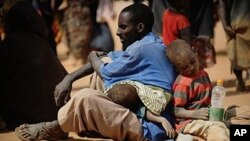The U.N. Children's Fund reports about 500,000 children in the Horn of Africa are at imminent risk of death due to malnutrition. The agency says another 1.7 million additional children also are at risk. Two senior officials from the U.N. refugee agency, who have just returned from Ethiopia and Kenya, confirm the gravity of the situation facing millions of drought victims, particularly the children.
The U.N. officials visited refugee camps in Dollo Abo in southeast Ethiopia and Dadaab in Kenya, the world’s largest, most congested refugee camp in the world. UNHCR Public Health Chief of Section Paul Spiegel says he was taken aback by the very dire situation in Dollo.
He says he was shocked at the extremely high mortality rate recorded in June.
“It was 7.4 deaths per 10,000 people per day. And, to put that into perspective, baseline for sub-Saharan Africa is 0.5 and an emergency is generally declared at greater than equal to one death. So, it is 15 times the baseline and the preponderance of the deaths are amongst under five children. Secondly the malnutrition rates, which is really one of the major causes of death are extremely high,” Spiegel said.
Data from the group, Doctors Without Borders, show global acute malnutrition rates in June in the camps were more than 50 percent and rates for severe malnutrition, which can lead to death, were 26.8 percent.
Spiegel says these findings are considered extremely rare and high. He notes acute severe malnutrition rates in July appear to be going down, which is a good sign.
The U.N. estimates more than 10 million people in the Horn of Africa are affected by drought. The situation is particularly serious in Somalia, which keeps churning out thousands of new refugees fleeing from drought and violence.
UNHCR Deputy Director for East and Horn of Africa Raouf Mazou says he was astonished at, what he calls, the unprecedented movement of populations going into Kenya and Ethiopia.
“At some point, we probably had between the two countries up to 4,000 people crossing every day. It has somehow reduced a bit. Again, somehow reduced a bit, but we should not think that this is a long-term trend or a long-term tendency. The situation in Somalia continues to be extremely difficult. As was said before, this terrible mix of drought and violence that continues in Somalia, which results in these type of movements,” Mazou said.
In Dollo, the refugee officials found camps filling up quickly. Dollo has two long-term camps and a third camp, which opened recently to accommodate new arrivals, is already crowded. The officials say a new camp, which can host 60,000 refugees, is due to open in the next two to three days.
They say camp conditions are very difficult and unhealthy. They say people are not getting enough water to drink and sanitary conditions are terrible because of a lack of latrines.
They warn conditions both in Dollo and in the huge, overcrowded Dadaab refugee complex in Kenya are ripe for epidemics of measles, water-borne and other diseases. They say no cases of cholera have been found, but this could quickly change as the number of cases of acute watery diarrhea is rising.
UN: 500,000 Malnourished Children at Risk in Horn of Africa









